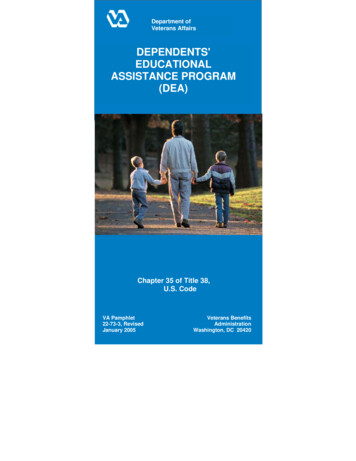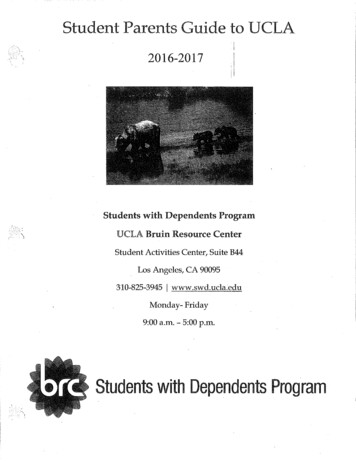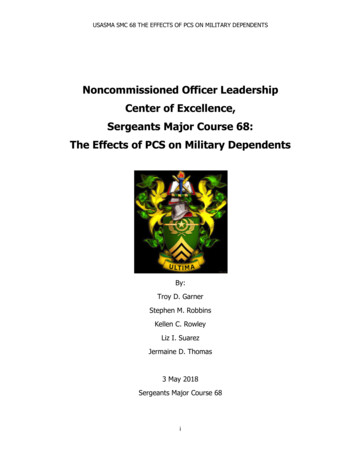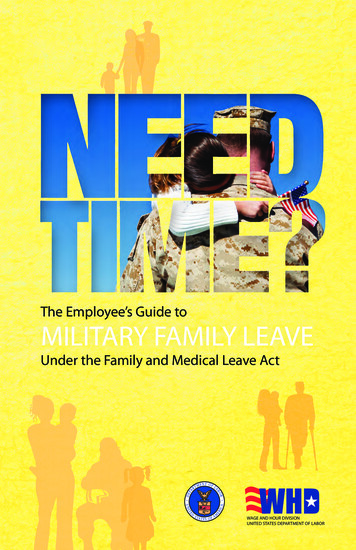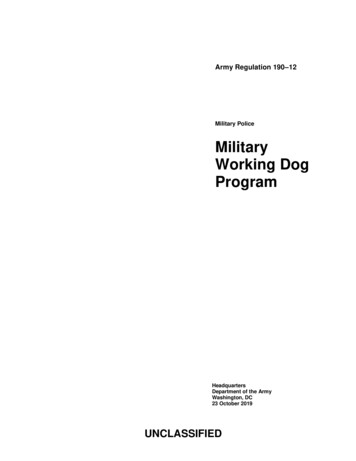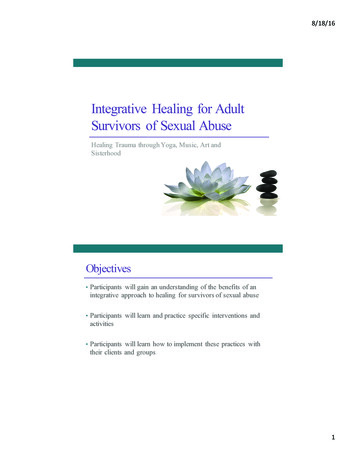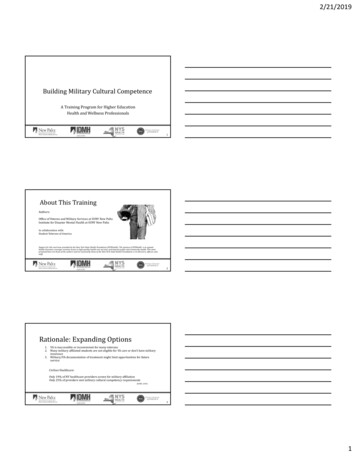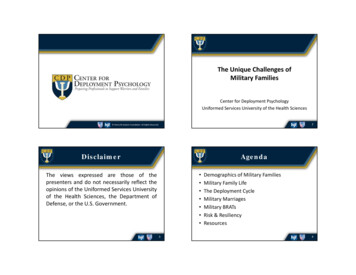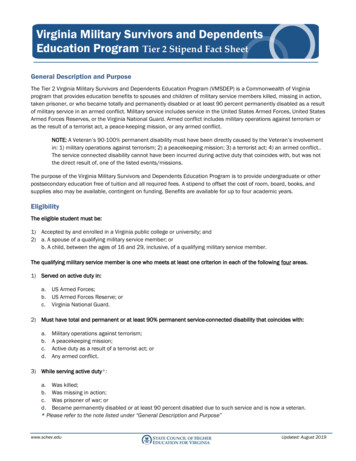
Transcription
Virginia Military Survivors and DependentsEducation Program Tier 2 Stipend Fact SheetFact SheetGeneral Description and PurposeThe Tier 2 Virginia Military Survivors and Dependents Education Program (VMSDEP) is a Commonwealth of Virginiaprogram that provides education benefits to spouses and children of military service members killed, missing in action,taken prisoner, or who became totally and permanently disabled or at least 90 percent permanently disabled as a resultof military service in an armed conflict. Military service includes service in the United States Armed Forces, United StatesArmed Forces Reserves, or the Virginia National Guard. Armed conflict includes military operations against terrorism oras the result of a terrorist act, a peace-keeping mission, or any armed conflict.NOTE: A Veteran’s 90-100% permanent disability must have been directly caused by the Veteran’s involvementin: 1) military operations against terrorism; 2) a peacekeeping mission; 3) a terrorist act; 4) an armed conflict.The service connected disability cannot have been incurred during active duty that coincides with, but was notthe direct result of, one of the listed events/missions.The purpose of the Virginia Military Survivors and Dependents Education Program is to provide undergraduate or otherpostsecondary education free of tuition and all required fees. A stipend to offset the cost of room, board, books, andsupplies also may be available, contingent on funding. Benefits are available for up to four academic years.EligibilityThe eligible student must be:1) Accepted by and enrolled in a Virginia public college or university; and2) a. A spouse of a qualifying military service member; orb. A child, between the ages of 16 and 29, inclusive, of a qualifying military service member.The qualifying military service member is one who meets at least one criterion in each of the following four areas.1) Served on active duty in:a.b.c.US Armed Forces;US Armed Forces Reserve; orVirginia National Guard.2) Must have total and permanent or at least 90% permanent service-connected disability that coincides with:a.b.c.d.Military operations against terrorism;A peacekeeping mission;Active duty as a result of a terrorist act; orAny armed conflict.3) While serving active duty*:a. Was killed;b. Was missing in action;c. Was prisoner of war; ord. Became permanently disabled or at least 90 percent disabled due to such service and is now a veteran.* Please refer to the note listed under “General Description and Purpose”www.schev.eduUpdated: August 2019
VMSDEP Fact Sheet, page 2 of 54) Have one of the following qualifying statuses:a.b.c.d.e.Virginia domicile at time of entering service or called up from reserves;Virginia domicile or physical presence in Virginia for at least five years immediately prior to student applying foradmission to the institution;If deceased, was a Virginia domicile or had physical presence in Virginia on, and for at least five years prior to,his death;In the case of a qualifying child, is deceased and the surviving parent had been, at some point previous tomarrying the deceased military member, a Virginia domicile for at least five years or is and has been a Virginiadomicile or has had physical presence in Virginia for at least five years prior to student’s application foradmission; orIn the case of a qualified spouse, is deceased and the surviving spouse had been, at some time previous tomarrying the deceased military spouse, a Virginia domicile for at least five years or is and has been a Virginiadomicile or has had physical presence in Virginia for at least five years prior to his or her admission application.BenefitsTuition/fee waiverEligible students, as confirmed by the Virginia Department of Veterans Services (DVS), are guaranteed waiver of alltuition and mandatory fees at a Virginia public college or university regardless of degree program or enrollment level.Note: Mandatory fees are those fees incurred after tuition is charged and does not include application or enrollmentfees.Stipend for eligible Tier 2 StudentsIn addition, as funds are available, eligible Tier 2 studentsmay receive a stipend to offset other educational expensesincurred by the student, such as room, board, books, andsupplies. Please note that the stipend is not available forthe advance purchase of books. The current maximumaward is 1,900, allocated to fall and spring termsaccording to the schedule on the right.Only students appearing on the verification rostersreleased by SCHEV to the institutions will be funded for theterms specified as authorized, regardless ofcertification/verification from any other source.Stipend priority funding system for fall and spring stipendsBecause there may not be sufficient funding to make full VMSDEP stipends to all eligible students, a priority fundingsystem will be used to determine the order and amount of stipends. Students in a higher Priority category must receivetheir full projected annual stipend, as determined by SCHEV based on student enrollment level, before subsequentcategories are considered for funding.Only students appearing on the verification rosters released by SCHEV to the institutions will be funded for the termsspecified as authorized, regardless of certification/verification from any other source.www.schev.eduUpdated: August 2019
VMSDEP Fact Sheet, page 3 of 5The priority dates are as follows: First Priority Date: December 1Includes fall and spring term authorizations received by SCHEV from DVS as of December 1. All students withinthis category will receive the same award amount for the equivalent enrollment level for each current year termauthorized by DVS by the first priority date. Second Priority Date: February 1Includes fall and spring term authorizations received by SCHEV from DVS between December 2 andFebruary 1. If funding remains after stipends for First Priority students are fully funded, stipends for SecondPriority students will be made. If remaining funds are insufficient to fund at the First Priority level, then areduction in the amount of all Second Priority stipends will be implemented, but all students within the categorywill receive the same award amount for the equivalent enrollment level for each current year term authorized byDVS by the second priority date. Third Priority Date: March 1Includes fall and spring term authorizations received by SCHEV from DVS between February 2 and March 1. Ifall stipends for First Priority and Second Priority students are fully funded at their respective stipend amountsand funds remain, stipends for Third Priority students will be made. If remaining funds are insufficient to fund atthe Second Priority level, then a reduction in the amount of Third Priority stipends will be implemented, but allstudents within the category will receive the same award amount for the equivalent enrollment level for eachcurrent year term authorized by DVS by the third priority date.If funds remain after the priority category authorizations for fall and spring are funded, additional stipends at the ThirdPriority level will be made on a first-come, first-served basis (based first on date of DVS notice of term authorization toSCHEV and then date of DVS term authorization) until May 8 or when funding is exhausted, whichever occurs first.No stipends can be funded once the annual deadline for requesting disbursement of funds to institutions has passed.Stipend priority funding system for summer stipendsIn May of each year, if all fall and spring term authorizations have been funded and sufficient funds remain, summerstipends will be awarded. Priority for summer awards will be based on a first-come, first served basis until funding isexhausted or the cut off for fiscal year disbursement requests, whichever occurs first. The first-come first-served basis isbased first on the date DVS provides notice of summer term authorization to SCHEV and second on the date that DVSauthorized the student for the summer term.No stipends can be funded once the annual deadline for requesting disbursement of funds to institutions has passed.If funds are available for summer stipends, students eligible for summer stipends are those:1) Who have been authorized by the Department of Veterans Services for summer benefits;2) For whom SCHEV has received DVS notice of summer authorization as of May 1 of the award year;3) Who have remaining eligibility (i.e., have not been awarded the full annual award during the fall and springterms);4) Who appear on the enrolling institution’s summer stipend roster;5) For whom the enrolling institution has received DVS notice of summer authorization; and6) Whose information appears on the roster completed by the institution and returned to SCHEV by the annualdeadline.www.schev.eduUpdated: August 2019
VMSDEP Fact Sheet, page 4 of 5Stipend restrictionsThe following restrictions apply to the stipend:1) Stipends are based on available funding and are awarded according to the above priority system.2) The stipend is not available for noncredit courses, which include courses taken for audit.3) For purposes of determining the stipend amount, the enrollment level is determined as of the end of theinstitution’s census date (end of add/drop period); credit hours added after that date may not be included in thestudent’s enrollment level.4) A student may receive the stipend through one institution only. If a student is enrolled concurrently at multipleparticipating institutions and there is a formal consortium agreement in place, the student may receive fundingbased on the combined enrollment. If there is no formal consortium agreement, the stipend amount will bebased and disbursed on the higher level of enrollment. However, a student remains eligible for the waiver oftuition and fees at each institution even if enrolled at multiple participating institutions.5) The maximum amount of the VMSDEP stipend, when combined with “other scholarships, grants, and waivers”(i.e. other gift aid), cannot exceed the student’s cost of attendance (tuition, fees, room, board, books, supplies,etc.). Other gift aid may include athletic or academic scholarships, tuition waivers, veteran’s benefits, etc.Example: John Smith is enrolled full-time for both fall and spring terms. His room, board, book, supply, andother expenses total 15,000. He expects to receive a 5,000 VMSDEP tuition and fee waiver, a 5,550Pell Grant, a 450 SEOG Grant, and a 3,000 institutional grant – a total of 14,000 in gift aid. Expenses( 15,000) minus expected gift aid ( 14,000) equals 1,000. Because the amount of the VMSDEP stipendcombined with other gift aid cannot exceed expenses, his annual VMSDEP stipend would be reduced to 1,000.6) If a student withdraws from college after the census date, the stipend is adjusted by a percentage equivalent tothe tuition refund policy in effect at the institution.Example: John Smith is receiving a 480 stipend for the spring term. He withdraws from the institution atthe point where a student would be liable for 50% of charges. John is eligible to retain 50% of his stipend,or 240.7) If a student is allowed to retroactively drop one or more courses after the census date, the student’s stipendamount is recalculated based on the current number of enrolled credit hours.8) No stipends will be awarded after the cut off for fiscal year disbursement requests has passed.RenewalBenefits are limited to a total of eight semesters, equivalent to four academic years; however, benefits do not have to beused in four consecutive years, allowing for a break or breaks in a student’s education. The stipend is contingent uponavailable annual funding.Stipend Process1) The student submits to DVS their VMSDEP application.Applications available online at: l; contact information:VMSDEP OfficePhone: (804) 225-2083Hours: Monday through Friday, 8:00 a.m. to 4:30 p.m.2) DVS reviews the application and determines eligibility.3) DVS provides an authorization letter to the student as well as the institution and then provides the authorizationinformation to SCHEV.4) SCHEV, working with the institution, verifies enrollment as of the end of the term’s drop/add date, determinesstudent’s final award amount for the term, and requests disbursement of funds to the institution approximately fourto six weeks into the term.5) The institution applies the funds to the student’s account.www.schev.eduUpdated: August 2019
VMSDEP Fact Sheet, page 5 of 56) Funds are first applied to institutional direct charges, such as room and board. Disbursements made by theinstitution to the student, if applicable, are then subject to the institution’s student refund policy.7) If the student withdraws after the census date, the award amount will be prorated based on the institution’s tuitionrefund policy.8) If a student is allowed to retroactively drop one or more courses after the census date, the student’s stipend amountis recalculated based on the current number of enrolled credit hours.Authorizing LanguageCode of Virginia § 23.1-608: 1/section23.1-608/2019 Virginia Acts of Assembly, Chapter 854:Item 141.F1. Out of this appropriation, 1,980,000 the first year and 1,980,000 the second year from the general fundis designated to support the Virginia Military Survivors and Dependents program, § 23.1-608, Code of Virginia,to provide up to a 2,200 annual stipend to offset the costs of room, board, books and supplies for qualifiedsurvivors and dependents of military service members.2. The amount of the stipend is an estimate depending on the number of students eligible under § 23.1-608,Code of Virginia. Changes that increase or decrease the grant amount shall be determined by the State Councilof Higher Education for Virginia.3. The Director, State Council of Higher Education for Virginia, shall allocate these funds to public institutions ofhigher education on behalf of students qualifying under this provision.4. Each institution of higher education shall report the number of recipients for this program to the StateCouncil of Higher Education for Virginia by April 1 of each year. The State Council of Higher Education forVirginia shall report this information to the Chairmen of the House Appropriations and Senate FinanceCommittees by May 15 of each year.5. The Department of Veterans Services shall consult with the State Council of Higher Education for Virginiaprior to the dissemination of any information related to the financial benefits provided under this program.Item 466C.1. Notwithstanding § 23.1-608, Code of Virginia, the department shall provide the State Council of HigherEducation in Virginia the information these schools need to administer the Virginia Military Survivors andDependent Education Program. The department shall retain the responsibility to certify the eligibility of thosewho apply for financial aid under this program.2. No surviving spouse or child may receive the education benefits provided by § 23.1-608, Code of Virginia,and funded by this or similar state appropriations, for more than four years or its equivalent.www.schev.eduUpdated: August 2019
The Tier 2 Virginia Military Survivors and Dependents Education Program (VMSDEP) is a Commonwealth of Virginia . Second Priority Date: February 1 Includes fall and spring term authorizations received by SCHEV from DVS between December 2 and February 1. If funding remains after stipends for First Priority students are fully funded, stipends .
